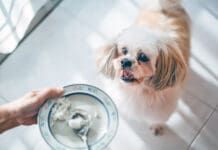We received a number of letters regarding our review of frozen dog treats, “Chilled Out,” published in the August 2002 issue. Most of the letter writers were concerned about the dietary sugar content of both the commercial treats we reviewed and in the whole-food, homemade alternatives we offered.
“You referenced making treats at home, flavoring the treats with cantaloupe, strawberries, etc. I thought sugar was bad for dogs and these fruits have sugar in them . . .”
“I was a bit puzzled to see vanilla yogurt recommended as a possible ingredient for a ‘pupsicle.’ Every vanilla yogurt label I’ve read has some kind of sugar in it. I don’t know about other folks, but I don’t like to give my dog any kind of sugar product if it can be avoided. It seems to me that sugar would be an ingredient to avoid if we are to give our canine friends the most healthy of treats and the best chance at a healthier life.”
First, there is no evidence that, in a healthy dog, low amounts of dietary sugar is hazardous to a dog’s health. (When we say “low amounts,” we mean low in relation to a dog’s normal diet. We’re discussing occasional treats, not a significant part of a dog’s daily diet.)
Of course, dogs who suffer health disorders that cause them to process sugar abnormally (such as diabetes mellitus or hyper-lipidemia) are well advised to avoid any foods or treats that contain sugar.
Dogs generally like sugar, which occurs naturally in certain foods, including fruit, milk, and vegetables. When dealing with anything that dogs eat, our bias is toward natural, whole foods, rather than artificial or highly processed ingredients. We’d rather see a dog eat a strawberry, for example, than a treat with an artificial strawberry-flavored, artificially sweetened treat. This may be an unscientific, instinctive response, but dogs (and people) have been eating real foods a lot longer than they have been eating artificial foods; we trust real foods more.
Speaking of real foods, one reader caught us making a throwaway reference to Häagen Dazs, her own favorite ice cream, and one she frequently feeds to her own dogs!
“Häagen Dazs contains nothing artificial – in fact, its vanilla flavor contains only five natural ingredients: milk, cream, eggs, sugar, and REAL vanilla (not vanillin). No fillers, preservatives, no nothing. Few people feed their dogs ice cream on a daily basis, but even dogs who don’t receive dairy products often seem to have little trouble with a Häagen Dazs ‘baby cone’ (i.e., a small serving – not a pint!)”
Okay, okay. Here are our parting words of wisdom about sweet treats for dogs:
When feeding anything new, start with a tiny amount and monitor your dog. If he suffers digestive upset or any other reaction, consider not feeding that food again.
Each dog will do best within a certain range of daily caloric intake. Nutritionally incomplete treats should not displace foods that are of greater benefit to the dog, nor should they routinely cause the dog to exceed his ideal caloric intake.
Finally, the following letter is a response from the maker of one of the commercial treats we reviewed:
“I am very pleased that [our product, Dog-E-Licious Ice Pudding, was] able to rank at the top of your list (3 paws) and that the Ice Pudding had universal appeal for your test dogs. However, I would like to clarify a couple of points:
“Glucono Delta Lactone (GDL) is a natural ingredient and not an artificial preservative. It is a natural constituent of many foods and helps preserve foods from deterioration by enzymes and microorganisms. Potassium sorbate is an artificial preservative (very small amount used) to prevent yeast formation due to high moisture. We were not able to find a natural product to accomplish this. This is why the label reads ‘natural ingredients with added vitamins, minerals, and preservatives.’
“We do not add ‘acidophilus’ but dried fermentation Lactobacillus acidophilus, lactis, and casei fermentation solubles. These are not live bacteria but byproducts of good bacteria that retard the growth of bad bacteria and encourage the growth of good bacteria in the small intestine . . .
“The simple sugars in our product include sucrose, maltodextrins, and glucose. These are commonly found in foods. The IcePudding contains about 27.5 calories per ounce. Dry dog foods range between 40-60 calories per ounce. The ingredients that you listed in your homemade treats included honey (1 tbsp = 90 cals) and banana (1 oz = 16 cals).
“Dogs eat fruits in order to obtain the simple sugars (sucrose, fructose, etc.) and get more energy. This is why they evolved with the dominate Type A (sweetness buds) in their mouth. Simple sugars excite their taste buds – just like humans. But, I agree with you that with 40 – 60 percent of dogs being obese, we must be cognizant of calories in our daily diet.
-Dr. Steve Tsengas
OurPet’s Company
———-
I love the Journal and have found it to contain very helpful articles, especially the “Danger Signals” article in the August issue. It did a good job of explaining what to look for on labels. I liked the suggestion that readers make and use their own nontoxic cleaners – something I would never have thought of doing! The problem is that it gave no information at all as to how to go about making them. How about an article that discusses how to make some nontoxic cleaners?
-Robin Riley
via e-mail
That’s a great idea, Robin. There are numerous resources for this information on the Internet, but it’s certainly worth a short article. We’ll prepare one as soon as possible. In the meantime, the following tips should be a good start:
Use a mixture of white vinegar and table salt in place of commercial abrasive cleansers.
Use baking soda to clean and deodorize kitchens and bathrooms. Use four tablespoons in a quart of warm water for general cleaning. Use baking soda on a damp sponge for grungier spots.
A half-cup of white vinegar in a half-gallon of hot water leaves vinyl floors sparkling clean.





